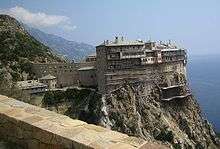Simonopetra
| Σιμωνόπετρα | |
|
Southern view of the monastery. | |
 Location within Mount Athos | |
| Monastery information | |
|---|---|
| Full name | Holy Monastery of Simonopetra |
| Other names | Simonos Petra |
| Order | Ecumenical Patriarchate |
| Established | 13th century |
| Dedicated to | Nativity of Jesus |
| Diocese | Mount Athos |
| People | |
| Founder(s) | Simon the Athonite |
| Prior | Archimandrite Elder Eliseus |
| Site | |
| Location | Mount Athos, Greece |
| Coordinates | 40°11′23″N 24°14′44″E / 40.189722°N 24.245556°E |
| Public access | Men only |
Simonopetra Monastery (Greek: Σιμωνόπετρα, literally: "Simon's Rock"), also Monastery of Simonos Petra (Greek: Μονή Σίμωνος Πέτρας), is an Eastern Orthodox monastery in the monastic state of Mount Athos in Greece. Simonopetra ranks thirteenth in the hierarchy of the Athonite monasteries.
The monastery is located in the southern coast of the Athos peninsula, between the Athonite port of Dafni and Osiou Grigoriou monastery. While the southern coast of Athos is quite rugged in general, the particular site upon which the monastery is built is exceptionally harsh. It is built on top of a single huge rock, practically hanging from a cliff 330 metres over the sea.[1] The monastery currently houses 54 monks, and the hegumen is Archimandrite Eliseus.
History
The monastery was founded during the 13th century by Simon the Athonite, who was later sanctified by the Eastern Orthodox Church as Osios Simon the Myrrohovletes. Tradition holds that Simon, while dwelling in a nearby cave, saw a dream in which the Theotokos instructed him to build a monastery on top of the rock, promising him that she would protect and provide for him and the monastery. The original monastery was called by Simon "New Bethlehem" (Greek: Νέα Βηθλεέμ) and is to this day dedicated to the Nativity of Jesus.
In 1364, the Serbian despot Jovan Uglješa funded the renovation and expansion of the monastery.
Russian pilgrim Isaiah wrote that, by the end of the 15th century, the monastery was Bulgarian.[2]
In 1581, Simonopetra was destroyed by a fire, in which a large portion of the monks died. Evgenios, the monastery's abbot traveled to the Danubian Principalities hoping to raise funds to rebuild the monastery. The most important donor was Michael the Brave, Prince of Wallachia, who donated large portions of land as well as money to the monastery. The monastery was also burnt in 1626, and the last great fire happened in 1891, after which the monastery was rebuilt to its current form.
During recent centuries, the monks of the monastery were traditionally from Ionia in Asia Minor. However, during the mid 20th century the brotherhood was greatly thinned out because of a great reduction in the influx of new monks. The current brotherhood originates from the Holy Monastery of Great Meteoron in Meteora as in 1973 the Athonite community headed by Archimandrite Emilianos decided to repopulate the almost abandoned monastery.
Architecture
The monastery consists of several multi-storeyed buildings, the main being in the place of the original structure, built by Simon. The main building has been described as the "most bold construction of the peninsula".[3] The monks of Simonopetra traditionally count the floors from top to bottom, thus the top floor is the first floor and the bottom floor the last. The monastery is built on top of the underlying massive rock, and the rock runs through the lower floors.
The expansion and development of Simon's original structure almost always followed one of the monastery's great fires. Following the 1580 fire and with the funds gathered by abbot Evgenios, the western building was erected. The eastern building was built following the 1891 fire mostly with funds raised in Russia.
Choir
The choir of Simonopetra has grown in reputation among Byzantine music specialists and enthusiasts. The monastery has published a series of collections of ecclesiastic Byzantine chants by the choir. Of these, Agni Parthene is the most popular and has earned the choir and the monastery widespread recognition.
Recordings include:
- Hymns from the Psalter (1990)
- O Pure Virgin (Agni Parthene) (1990)
- Divine Liturgy (1999)
- Great Vespers (1999)
- Paraklesis (1999)
- Service of Saint Simon (1999)
- Sunday Matins (Orthros) (1999)
- Service of St. Silouan the Athonite (2004)
Gallery
 Simonopetra
Simonopetra Simonopetra
Simonopetra Simonopetra
Simonopetra
References
- ↑ mountathos.gr
- ↑ A. E. Bakalopulos (1973). History of Macedonia, 1354-1833. [By] A.E. Vacalopoulos. p. 166.
At the end of the 15th century, the Russian pilgrim Isaiah relates that the monks support themselves with various kinds of work including the cultivation of their vineyards....He also tells us that nearly half the monasteries are Slav or Albanian. As Serbian he instances Docheiariou, Grigoriou, Ayiou Pavlou, a monastery near Ayiou Pavlou and dedicated to St. John the Theologian (he no doubt means the monastery of Ayiou Dionysiou), and Chilandariou. Panteleïmon is Russian, Simonopetra is Bulgarian, and Karakallou and Philotheou are Albanian.
- ↑ Greek Ministry of Culture
External links
- Simonopetra monastery at the Mount Athos website
- Liturgica.com: the recordings of the choir of Simonopetra
- History of monastery (grec.)
| Wikimedia Commons has media related to Moni Simonos Petras (Athos). |
